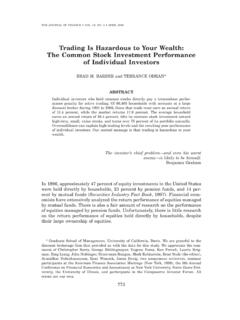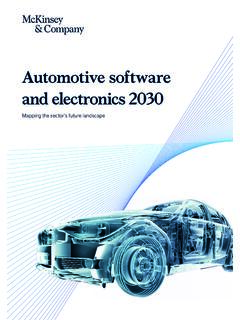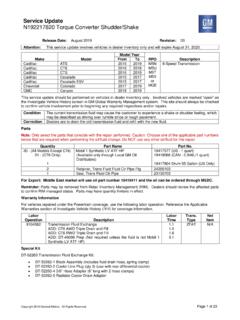Transcription of Transformation of urgent and emergency care models of …
1 Classification: Official Publications approval reference: PAR122 Transformation of urgent and emergency care: models of care and measurement December 2020 2 | Transformation of urgent and emergency care: models of care and measurement Contents Preface .. 3 1. Executive Summary .. 4 2. Introduction .. 7 Context .. 8 Covid-19: Shifting the urgent and emergency care paradigm .. 9 Measuring what is clinically relevant Findings from the Clinically-Led Review of Standards .. 10 Next steps for Clinically-led Review of Standards workstreams outside of this report .. 13 Principles of urgent and emergency Care service design.
2 13 3. Transforming access to UEC services: Changing behaviours and the role of NHS 111 .. 15 What this means for patients .. 15 4. 999 ambulance services: Optimising performance and reducing wider service pressures19 5. urgent Treatment Centres: Improving access, capacity and capability .. 21 6. Improving flow through hospitals: emergency Departments and Same Day emergency Care .. 23 7. Managing hospital occupancy .. 27 In-hospital reduction in length of stay .. 27 Discharge and community response .. 28 8. Measuring performance in a transformed system .. 30 Proposed New Bundle of Standards by the Clinically-led Review of Standards.
3 32 Presenting the bundle of measures .. 32 Setting thresholds for the new measures .. 34 A new offer to the public .. 35 1. In an emergency , 999 ambulance services will get the right vehicle to you quickly.. 36 Your Views .. 37 Engagement Questions .. 37 How to respond .. 39 9. Moving towards a transformed healthcare system .. 40 10. Conclusion .. 42 Appendix A: Oversight and Advisory Group Membership .. 43 3 | Transformation of urgent and emergency care: models of care and measurement Preface Our urgent and emergency care services play a pivotal role in providing the care that people need, but pressures have risen every year.
4 The number of patients attending our emergency departments (EDs) has risen by 40% over the last 15 years. At the same time the numbers of inpatient beds have fallen, and following a recent increase, the prevention and control measures necessary to tackle the Covid-19 pandemic have required further reduction in available bed capacity. During the winter of 2019/20, immediately before the onset of the Covid-19 pandemic, the pressure on our acute hospital bed base resulted in unacceptable crowding in our EDs and, in some cases, patients being cared for in inappropriate environments commonly referred to as corridor care. This is unacceptable for our patients and, collectively, the NHS is committed to ensuring that crowding does not occur in EDs.
5 Building on The NHS Long Term Plan, we set out here the next steps to transform urgent and emergency care for patients, drawing on the learning from the coronavirus pandemic and building on the findings of the Clinically-led Review of Standards (CRS). Our ambition remains to strengthen the offer for patients, delivering improved access and outcomes, addressing health inequalities and giving a better experience of care. We also want to introduce improved ways of accessing care online and on the phone from NHS 111, at home from a paramedic, and provide booked time slots for care in an emergency department. Through changing the way that the urgent and emergency care system is both perceived and accessed by the patient, we will improve services and reduce the risk to patients by minimising unnecessary healthcare contacts.
6 In June 2018 the Prime Minister asked for a clinically-led review of the NHS access standards to ensure they measure what matters most to patients and clinically. This report also sets out a new approach to measuring what is clinically relevant, offering a holistic view of performance, developed with clinical system leaders. Professor Stephen Powis Pauline Philip DBE National Medical Director National Director of emergency and NHS England and NHS Improvement Elective Care NHS England and NHS Improvement 4 | Transformation of urgent and emergency care: models of care and measurement 1. Executive Summary This report sets out the final recommendations on the urgent and emergency care (UEC) standards from the Clinically-led Review of NHS Standards (CRS) and gives patients, clinicians and the public an opportunity to respond to these findings in a consultation (see Chapter 8 for details of how to respond).
7 It also sets out how the proposed measures align with the strategy for transforming urgent and emergency care provision, drawing on the learning from experience through Covid-19 and building on our longstanding vision for the services. As set out in the Interim Report1 of the Clinically-led Review of NHS Access Standards (March 2019), the current headline four-hour access standard is used to measure and report performance against one aspect of the urgent and emergency care system. It has proved useful in improving levels of staffing and investment in emergency Departments (EDs), improving flow through hospitals including improving access to diagnostic services and reducing time spent in ED, and permits comparison of individual healthcare organisations and health systems.
8 However, as the Interim report set out, given the changing nature of urgent and emergency care services, the view of the CRS is that the current single standard offers a limited insight into the care that patients receive, including: not measuring total waiting times; not differentiating between severity of condition; measuring a single point in often very complex patient pathways; and hospital processes, rather than clinical judgement, are resulting in admissions or discharge in the immediate period before a patient breaches the standard. This report considers the recommendations of the CRS alongside the continuing development of urgent and emergency care services.
9 Our ambition is to improve the offer for patients, deliver improved access and outcomes with a better experience of care. The proposed new measures are part of our vision for the Transformation of UEC, which combined will support improvements in care by changing the way that the urgent and emergency care system is both perceived and accessed by the patient, as well as reducing the risk to patients by minimising unnecessary healthcare contacts. We continue to build on the success of the Ambulance Response Programme (ARP) and support ambulance services to offer the most clinically appropriate response to patients, including telephone advice or treatment at scene.
10 We also describe the development of NHS 111 to enhance the approach to remote clinical triage with the goal of directing 1 NHS. Interim Report of the Clinically-led Review of NHS Access 5 | Transformation of urgent and emergency care: models of care and measurement patients to the service that best meets their needs and enables a booked time slot to be made whenever possible, including in emergency Departments, urgent Treatment Centres and primary and community care. This builds on the increased adoption of Same Day emergency Care to ensure patients get the right care in the right place, at the right time, and avoid unnecessary hospital admissions.















